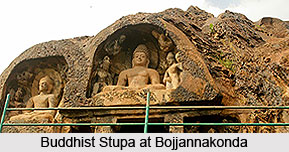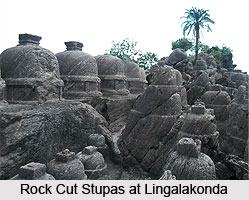 Bojjannakonda and Lingalakonda, situated in Visakhapatnam district of Andhra Pradesh, are ancient Buddhist sites. Located on the hillocks near Sankaram village, they are associated with 4th to 9th Century A.D. It is believed that during this era three phases of Buddhism namely Vajrayana, Mahayana and Hinayana thrived in this region. Bojjannakonda is on the east hillock of the village whereas Lingalakonda is on the western hillock. Both the sites are encircled by paddy fields and both of them house a number of monasteries, chaityas, rock-cut caves and monolithic stupas. During ancient times, the place was enlisted amongst the most remarkable Buddhist centres of the state.
Bojjannakonda and Lingalakonda, situated in Visakhapatnam district of Andhra Pradesh, are ancient Buddhist sites. Located on the hillocks near Sankaram village, they are associated with 4th to 9th Century A.D. It is believed that during this era three phases of Buddhism namely Vajrayana, Mahayana and Hinayana thrived in this region. Bojjannakonda is on the east hillock of the village whereas Lingalakonda is on the western hillock. Both the sites are encircled by paddy fields and both of them house a number of monasteries, chaityas, rock-cut caves and monolithic stupas. During ancient times, the place was enlisted amongst the most remarkable Buddhist centres of the state.
Bojjannakonda
The eastern hill of Sankaram village is recognized as Bojjannakonda which hosts a Maha Stupa surrounded by a huge group of monolithic Stupas along its rock cut platform. The dome of the main Stupa is made of bricks whereas the surrounding Stupas are composed of bricks and rocks. At the foot of the hill, an idol of Goddess Hariti has been found by the archaeology department.
 Apart from this, the hill also houses six rock-cut caves, some of which have sculptured panels. Each of the panel has the images of seated Buddha and his attendants. Towards the north of the Maha Stupa, terraced Chaitya Grihas are present. These are believed to be the monasteries of the Buddhist monks. In ancient times, several Buddhist monks used to worship here for which it was known as `Buddhuni konda` which refers to `hill of the Buddha`. But later over time, the place came to be known as Bojjannakonda. The place is also an important centre for the huge celebration of Vaisakha Pournami.
Apart from this, the hill also houses six rock-cut caves, some of which have sculptured panels. Each of the panel has the images of seated Buddha and his attendants. Towards the north of the Maha Stupa, terraced Chaitya Grihas are present. These are believed to be the monasteries of the Buddhist monks. In ancient times, several Buddhist monks used to worship here for which it was known as `Buddhuni konda` which refers to `hill of the Buddha`. But later over time, the place came to be known as Bojjannakonda. The place is also an important centre for the huge celebration of Vaisakha Pournami.
Lingalakonda
Lingalakonda is the western hill of Sankaram village. It houses numerous rock cut small Stupas. Excavations in this region have also furnished several antiquities. The common artefacts that have been discovered from Lingalakonda include terracotta figures, terracotta beads, terracotta inscribed tablets, coins of gold, copper and lead, copper and lead seals and many more.
During the growth of Buddhism several learning centres were established in various regions of the country, some of which can be witnessed in Bojjannakonda and Lingalakonda too. With the revival of Hinduism the significance of these centres however started to fade out.



















